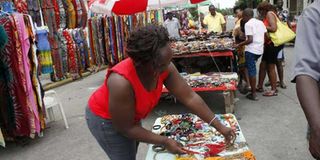SMEs hit hard as banks cut lending, turn to government securities

A trader sells her wares along Customs Road in Mombasa. The ugly side of the interest rate caps is hitting home as lending to small and medium enterprises dwindles, with banks preferring to invest in risk-free government securities. PHOTO | FILE | NATION MEDIA GROUP
What you need to know:
- This translates to slower economic growth and few jobs being created.
- Constrained credit to SMEs also means the government is losing on taxes.
- CBK data shows that domestic borrowing by the government grew by Sh293.5 billion in the first nine months of 2018.
The ugly side of the interest rate caps is hitting home as lending to small and medium enterprises dwindles, with banks preferring to invest in risk-free government securities.
Reduced lending to SMEs, which is evident in bigger average size of loans being given by banks, means less money for start-ups and business expansion.
This translates to slower economic growth and few jobs being created.
SOCIAL IMPACT
The adverse social impact of the caps that came into force in September 2016 has been compounded by the government’s high appetite for domestic borrowing that has seen banks make astronomical profits.
The latest results by the top five lenders in Kenya show that they raked in Sh56 billion in net profits, Sh6 billion higher than in the same period last year.
The five — KCB, Equity, Cooperative, Standard Chartered and Barclays — largely attributed their earnings to investment in government debt.
Kenya Bankers Association chairman Habil Olaka told the Saturday Nation that lenders are just reacting to the money pricing law.
“Banks lend on the basis of risk and returns. If the government is offering opportunities at low risk and better returns, that is a better option. The lending appetite has to be lower for SMEs, whose risks cannot even be priced within the controlled rates,” Mr Olaka said.
He added that SMEs are largely informal and poorly structured, raising the probability of default.
TAXES
Constrained credit to SMEs also means the government is losing on taxes as well as its target of creating a million jobs every year.
SMEs account for more than 90 per cent of the jobs created annually.
Kiambu Central MP Jude Njomo, who tabled the bill capping lending rates, says the shift is part of the ‘hard ball’ strategy by banks to make the government revert to the free market regime.
“That is the picture banks want to portray. It is meant to arm-twist the government but we just need to observe the trend for a year or so then decide on how to encourage banks to lend to SMEs even if it means cutting back government borrowing from the local market,” Mr Njomo said.
Already, the National Treasury has proposed that deposit rates be freed but the World Bank says this would only help banks make more without lending to the productive industry.
CBK REPORT
The March Central Bank of Kenya report showed that sectors where SMEs are dominant had the biggest increase in the average size of loans.
The bigger the loan size, the more established a borrower. That means SMEs are being pushed out of credit.
Only in the personal and household industry did the average size of loan reduce.
In contrast, the average loan in areas where SMEs are active — trade, agriculture, manufacturing, financial services, energy and water, building and construction and tourism — increased by between 44 and 77 per cent.
SMEs have also been hit by the government not paying them for supplies and services, a debt that is more than Sh90 billion.
The impact of the credit squeeze is reflected in the latest Kenya National Bureau of Statistics report, showing that outside government-related activities — read infrastructure — real economic activity expanded by 2.9 per cent in 2017. Bank vaults were getting bigger in the same period.
KCB, Kenya’s biggest bank by assets, grew its net earnings by 7.6 per to Sh18.04 billion from Sh15.08 billion a year earlier.
GOVERNMENT DEBT
Investment in government debt rose to 10.9 per cent to Sh100.6 billion in the nine months to September 2018.
Lending to the government also helped boost its total interest income to Sh49.1 billion, even as the secure loans enabled the lender to slash its provision for bad debt by 42.6 per cent to Sh1.7 billion.
Its closest rival, Equity Bank, used almost the same formula to rise 8.1 per cent in net earnings of Sh15.8 billion during the same period.
Interest income (yield from loans) which was essentially expected to reduce profits because of the rate capping was ironically the bank's key driver for higher profit, recording a 7.2 per cent rise to Sh29.5 billion.
Co-operative bank’s eight per cent growth in profit after tax to Sh10.31 billion was also largely pegged on aggressive lending to the government.
Its investment in government securities grew by 22 per cent to Sh83.25 billion compared to Sh68.09 billion in 2017.
CBK data shows that domestic borrowing by the government grew by Sh293.5 billion in the first nine months of 2018 to Sh2.54 trillion.
The uptake of domestic debt during the period is behind the fast growth of public debt which has since passed the Sh5 trillion mark.





